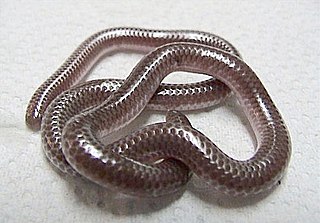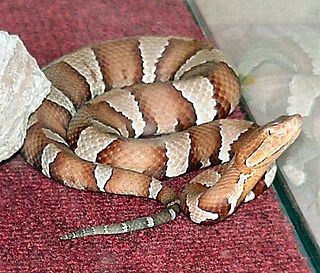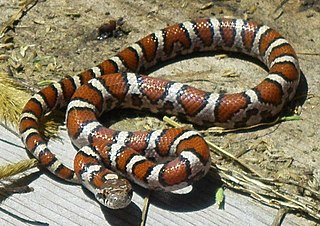
The corn snake is a species of North American rat snake in the family Colubridae. The species subdues its small prey by constriction. It is found throughout the southeastern and central United States. Though superficially resembling the venomous copperhead and often killed as a result of this mistaken identity, the corn snake lacks functional venom and is harmless. The corn snake is beneficial to humans because it helps to control populations of wild rodent pests that damage crops and spread disease.

Kingsnakes are colubrid New World members of the genus Lampropeltis, which includes 26 species. Among these, about 45 subspecies are recognized. They are nonvenomous and ophiophagous in diet.

The scarlet kingsnake or scarlet milk snake is a species of kingsnake found in the southeastern and eastern portions of the United States. Like all kingsnakes, they are nonvenomous. They are found in pine flatwoods, hydric hammocks, pine savannas, mesic pine-oak forests, prairies, cultivated fields, and a variety of suburban habitats; not unusually, people find scarlet kingsnakes in their swimming pools, especially during the spring. Until recently, and for much of the 20th century, scarlet kingsnakes were considered a subspecies of the milk snake; however, Pyron and Bubrink demonstrated the phylogenetic distinction of this species and its closer relationship to the mountain kingsnakes of the southwestern United States. These largely fossorial snakes are the smallest of all the species within the genus Lampropeltis, usually ranging from 40 to 50 cm at maturity. The maximum recorded length is in Jonesboro, AR 76.2 cm (30.0 in). Hatchlings range in size from 8 to 18 cm .

Rena humilis, known commonly as the western blind snake, the western slender blind snake, or the western threadsnake, is a species of snake in the family Leptotyphlopidae. The species is endemic to the southwestern United States and northern Mexico. Six subspecies are currently recognized, including the nominate subspecies described here.

Rena dulcis, also known commonly as the Texas blind snake, the Texas slender blind snake, or the Texas threadsnake, is a species of snake in the family Leptotyphlopidae. The species is endemic to the Southwestern United States and adjacent northern Mexico. Three subspecies are currently recognized, including the nominate subspecies described here.

Tropidoclonion is a genus of snake in the subfamily Natricinae of the family Colubridae. The genus is monotypic, containing the sole species Tropidoclonion lineatum, commonly known as the lined snake. The species is endemic to North America.

The Trans-Pecos rat snake or Davis Mountain rat snake, is a species of medium to large, nonvenomous rat snake in the family Colubridae. Bogertophis subocularis is endemic to the Chihuahuan Desert.

The speckled kingsnake is a nonvenomous species of kingsnake endemic to the United States.
Roger Conant was an American herpetologist, author, educator and conservationist. He was Director Emeritus of the Philadelphia Zoo and adjunct professor at the University of New Mexico. He wrote one of the first comprehensive field guides for North American reptiles in 1958 entitled: A Field Guide to Reptiles and Amphibians of Eastern and Central North America, in the Peterson Field Guide series.

Hypsiglena jani, commonly known as the Texas night snake or the Chihuahuan night snake, is a small species of mildly venomous snake in the family Colubridae. The species is native to the southwestern United States and adjacent northeastern Mexico.

Cemophora coccinea copei, commonly known as the northern scarlet snake, is a subspecies of harmless colubrid snake that is native to the southern and eastern United States.
The Texas scarlet snake is a species of nonvenomous snake in the family Colubridae. The species is endemic to the South Central United States. It was previously considered a subspecies of Cemophora coccinea.

Agkistrodon contortrix pictigaster was formerly a venomous pit viper subspecies found in the Trans-Pecos region of the United States in western Texas, and northeastern Mexico. However, recent taxonomic changes do not recognize the Trans-Pecos copperhead as a valid taxon.
The Brazos water snake, also called commonly Harter's water snake, is a species of mostly aquatic, nonvenomous snake in the family Colubridae. The species is endemic to Texas in the United States.
Kenneth Lee Williams was an American herpetologist and author of books on the subject of snake biology and classification. Williams retired from teaching in Northwestern State University's biology department and received emeritus status in 2001. Williams is considered an authority on the milk snake and the herpetology of the Honduran Cloud Forest.

Lampropeltis getula, commonly known as the eastern kingsnake, common kingsnake, or chain kingsnake, is a harmless colubrid species endemic to the United States and Mexico. It has long been a favorite among collectors. Nine subspecies are currently recognized, including the nominate subspecies described here.

The short-tailed snake is a small harmless colubrid snake. Fossorial and seldom seen, it is found only in sandy, upland parts of Florida where it is listed as Threatened and is protected by state law.

Lampropeltis rhombomaculata, commonly known as the mole kingsnake or the brown kingsnake, is a species of snake in the family Colubridae. It is a relatively medium-sized snake that occupies a variety of habitats from Baltimore, Maryland, south through the Florida Panhandle and west into Mississippi and Tennessee.

Lampropeltis triangulum triangulum, commonly known as the eastern milk snake or eastern milksnake, is a subspecies of the milk snake. The nonvenomous, colubrid snake is indigenous to eastern and central North America.
William Franklin Blair was a zoologist and president of the Ecological Society of America.



















